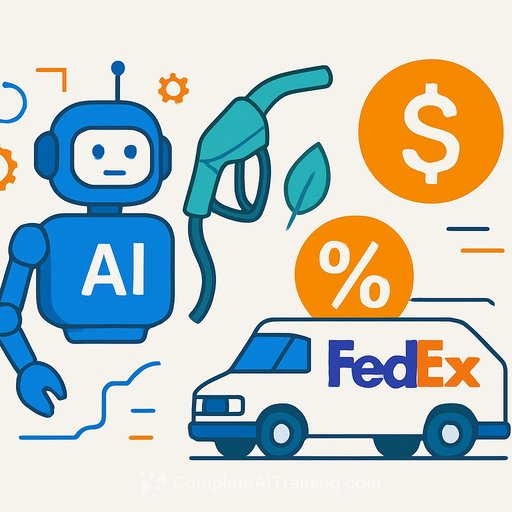FedEx (FDX): Valuation Through an Operations Lens After Moves in Sustainability and AI
FedEx has been busy. Early adoption of sustainable aviation fuel (SAF), upgrades to AI-driven operations, and a disciplined response to regulation are showing up in performance metrics and market sentiment.
The stock gained 9.2% in the past month and 14.9% over the last quarter. It's still down 4.4% year-to-date, but the three-year total shareholder return sits near 59.5%-clear payoff for patient holders despite short-term noise.
A widely followed view pegs fair value at $267.71 versus a recent close of $262.09-about 2.1% under. It's a tight gap, which says the market is watching execution more than headlines.
The Operating Levers Behind That Valuation
- Structural cost-out: The DRIVE program targets $2.2B of savings in FY '25 and $4B versus the FY '23 baseline. That compounds into net margin gains if the cuts stick.
- AI in the workflow: Smarter sortation, dispatch, ETA accuracy, and exception handling reduce rework and cost per stop. The bigger the network, the bigger the payoff from small accuracy improvements.
- Sustainable aviation fuel: Early SAF adoption hedges against carbon costs and future rules. It also pressures competitors to catch up on fuel strategy and supplier contracts.
- Regulatory posture: Proactive alignment with emissions and safety standards lowers surprise costs and keeps the network fluid under shifting rules.
What the Numbers Imply
- Fair value marker: $267.71 vs. $262.09 suggests modest upside if cost savings flow through and volumes stabilize.
- Margin setup: Structural reductions (not just headcount) are the difference between a one-off quarter and a durable reset. DRIVE points to the latter.
- Sensitivity: Yields, fuel, and network utilization do most of the valuation work now. A slight miss on utilization can erase 2% quick.
Metrics Ops Leaders Should Track (and Act On)
- On-time performance by lane and product (priority vs. economy).
- Cost per stop and cost per piece (ground vs. air).
- Sort productivity per labor hour and peak vs. off-peak variance.
- Linehaul and aircraft utilization; empty miles and mix shift.
- SAF blend percentage and per-gallon premium vs. conventional jet fuel.
- Fuel surcharge lag and recovery rate.
- Automation uptime (sorters, vision systems, robotics) and mean time to repair.
- Exception rate, first-attempt delivery rate, and rework percentage.
- Cycle time through major hubs and dwell time on trailers/containers.
Execution Risks (and Practical Mitigations)
- Soft freight demand: Flex staffing, cross-training, and dynamic linehaul plans. Tie labor hours to real-time volume signals.
- Key account churn: Quarterly "red list" reviews, executive coverage on top 20 contracts, and shared forecasting with customers.
- AI model drift: Monitor feature drift, A/B guardrails, and rollback playbooks. Track ETA error bands, not just averages.
- SAF supply and price volatility: Dual-source, long-dated contracts, and blend flexibility by lane.
- Labor and safety: Ergonomics, near-miss tracking, and incentive structures that reward throughput without cutting corners.
- Cyber and network resilience: Segment critical systems, run tabletop outages, and measure recovery time to SLA.
Operator Playbook: Convert Strategy Into P&L
- Lock in DRIVE gains with standard work, checklists, and weekly variance reviews by site.
- Put AI where it pays now: forecasting, dynamic routing, sortation sequencing, and exception prevention.
- Clean the data: unique IDs, scan compliance, and event time-stamping. Bad scans cost more than slow conveyors.
- Shift the air-ground mix with lane-level profitability, not averages. Kill sacred routes if they miss hurdle rates.
- Stand up a control tower: one view of network health, with alerts tied to actions-not just dashboards.
- Make SAF a sourcing program, not a press release. Blend targets, contracts, and unit economics in the same plan.
Why This Matters for Valuation
At a 2.1% discount to a widely cited fair value, the market is saying "prove it." The proof is operational: capture the $2.2B FY '25 savings, hold service levels, and keep capex disciplined.
If those hold while demand stabilizes, the spread can close. If freight stays soft or a major contract rolls off, the gap can widen fast.
What to Watch Next Quarter
- Sequential change in cost per stop and sort productivity.
- ETA accuracy and exception rate trend during peak windows.
- Air-to-ground mix shift and utilization improvements in core lanes.
- SAF blend percentage and any disclosed fuel cost deltas.
Context and Further Reading
Upskill Your Ops Team on AI Execution
If you're building AI into dispatch, forecasting, or control towers and want focused learning paths for operators, explore curated programs here:
This article is general commentary based on publicly shared figures and projections. It is not financial advice.
Your membership also unlocks:






